Easy Bibim Guksu (Korean Cold Kimchi Noodles)
Bibim guksu is a spicy Korean cold noodle dish made with somyeon, gochujang, and kimchi. Light and refreshing, it’s perfect for hot days. Top with crisp veggies and egg—ready in just 20 minutes!
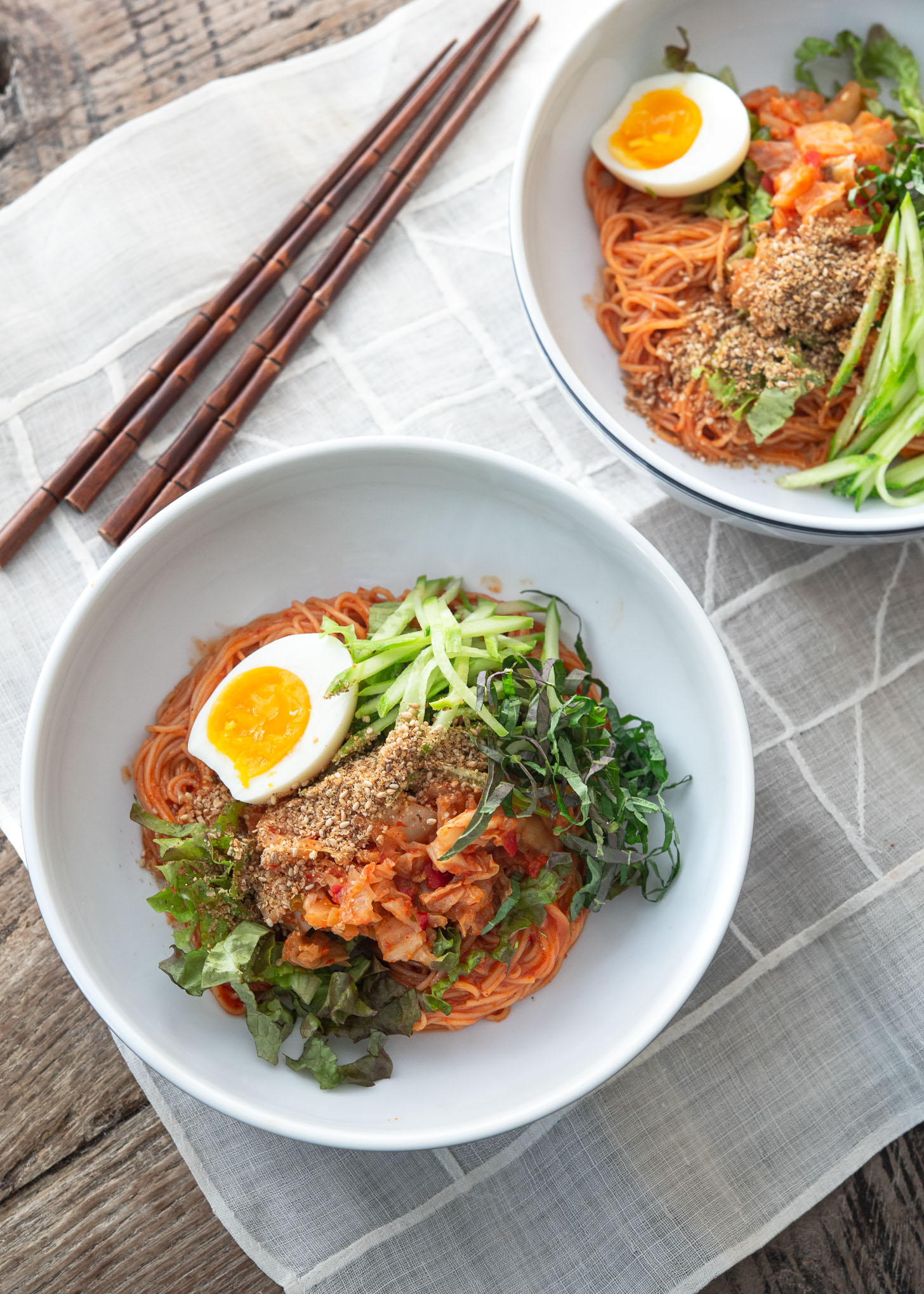
Bibim guksu is a spicy Korean cold noodle dish that’s fast, refreshing, and packed with flavor—my go-to when summer hits and standing over a hot stove feels like punishment.
Thin wheat noodles get shocked in ice water, tossed in a punchy gochujang-plum sauce, and piled high with kimchi and crunchy veggies. Ten minutes of cooking, no broth to fuss with—just cool, spicy noodles that hit the spot.
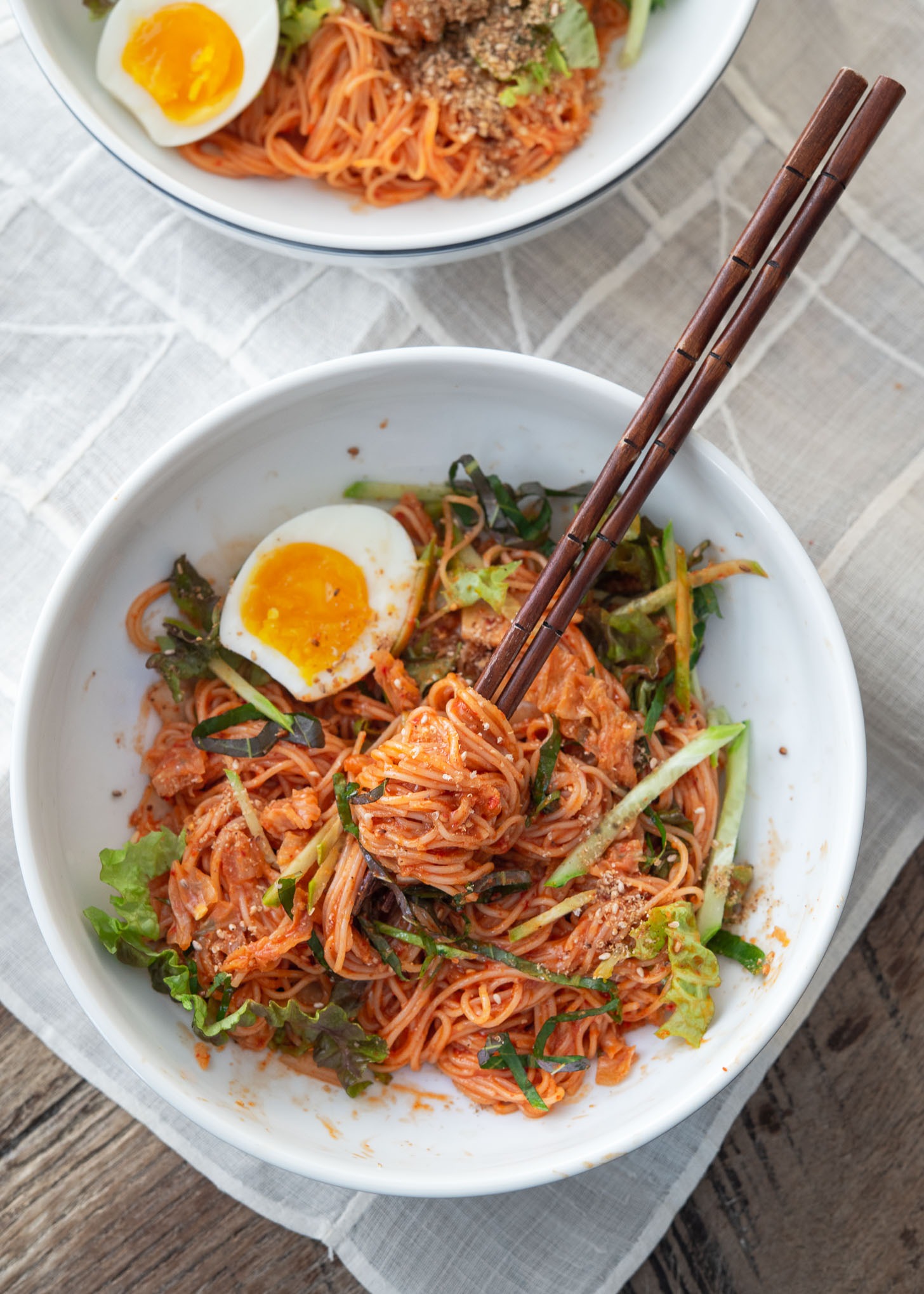
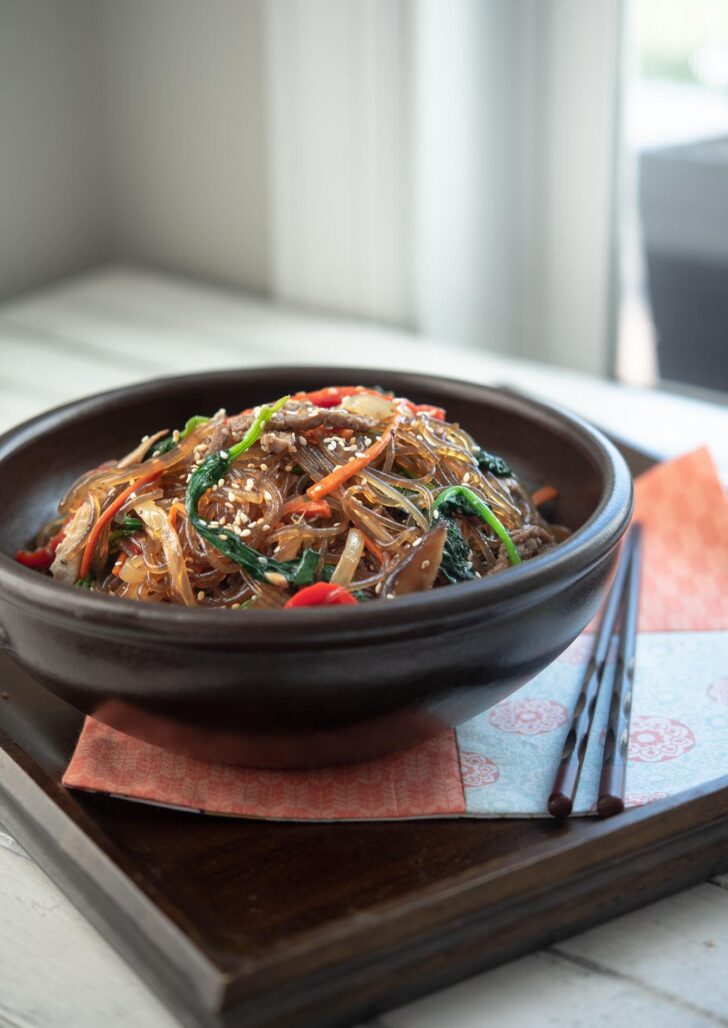
Get new recipes via email:
Back in Korea, this was the dish my mom turned to when no one could bear the heat—or wait. We’d sometimes have bibim naengmyeon, a spicy Korean cold noodle dish made with buckwheat noodles, but it takes more prep and often calls for a chilled broth or pre-made base.
But bibim guksu? That was the quick fix. Easier, speedier, and made with whatever was in the fridge.
My siblings and I could inhale a bowl of these cold kimchi noodles in under two minutes flat. No exaggeration—it’s that good.
And hey—don’t confuse it with bibimbap just because they share the word bibim (meaning “mixed”). Bibimbap is mixed rice. Bibim guksu is mixed noodles. Both are delicious, but today, we’re here for the spicy, cold noodle kind.
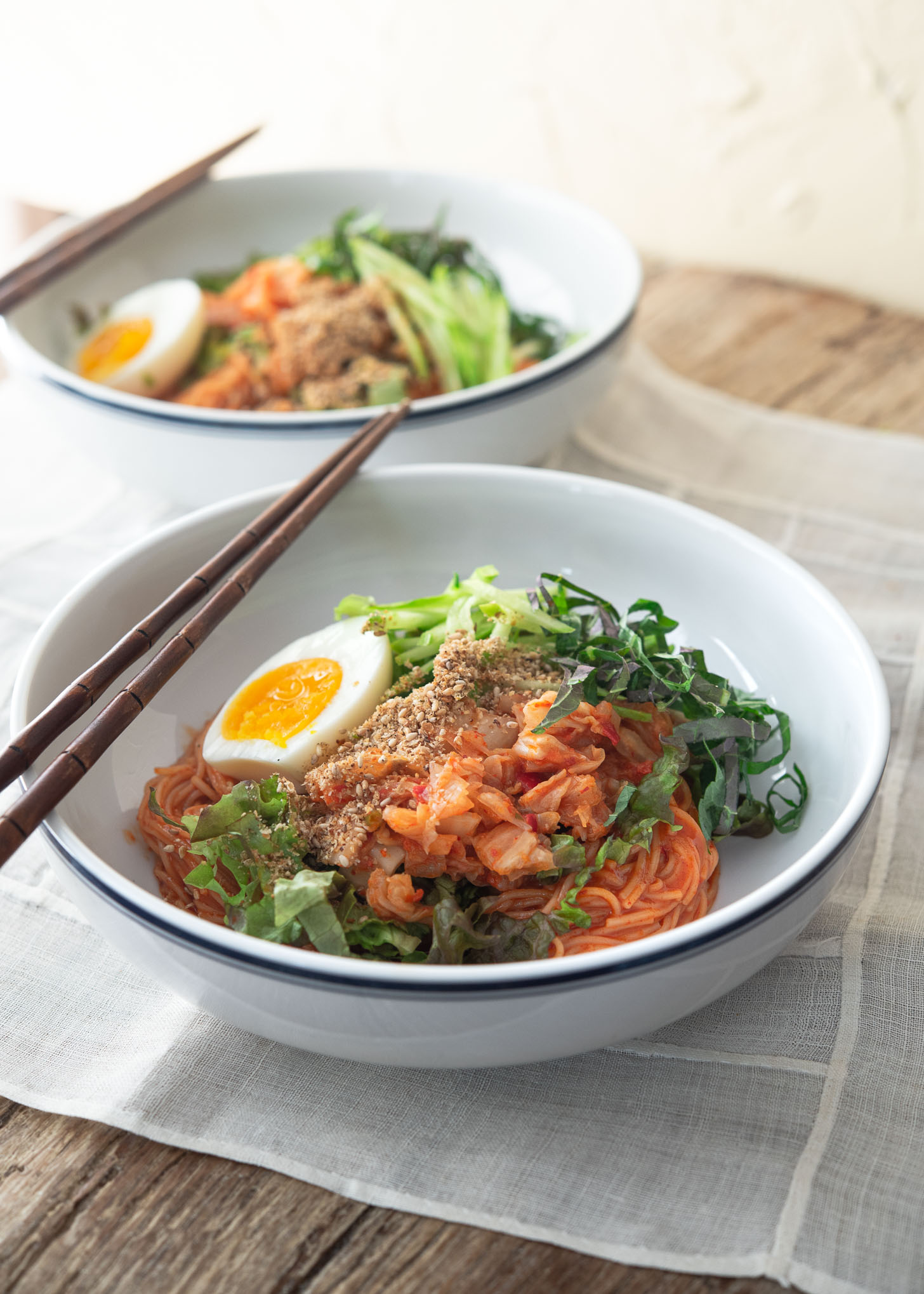
Key Ingredients for Spicy Korean Cold Noodles
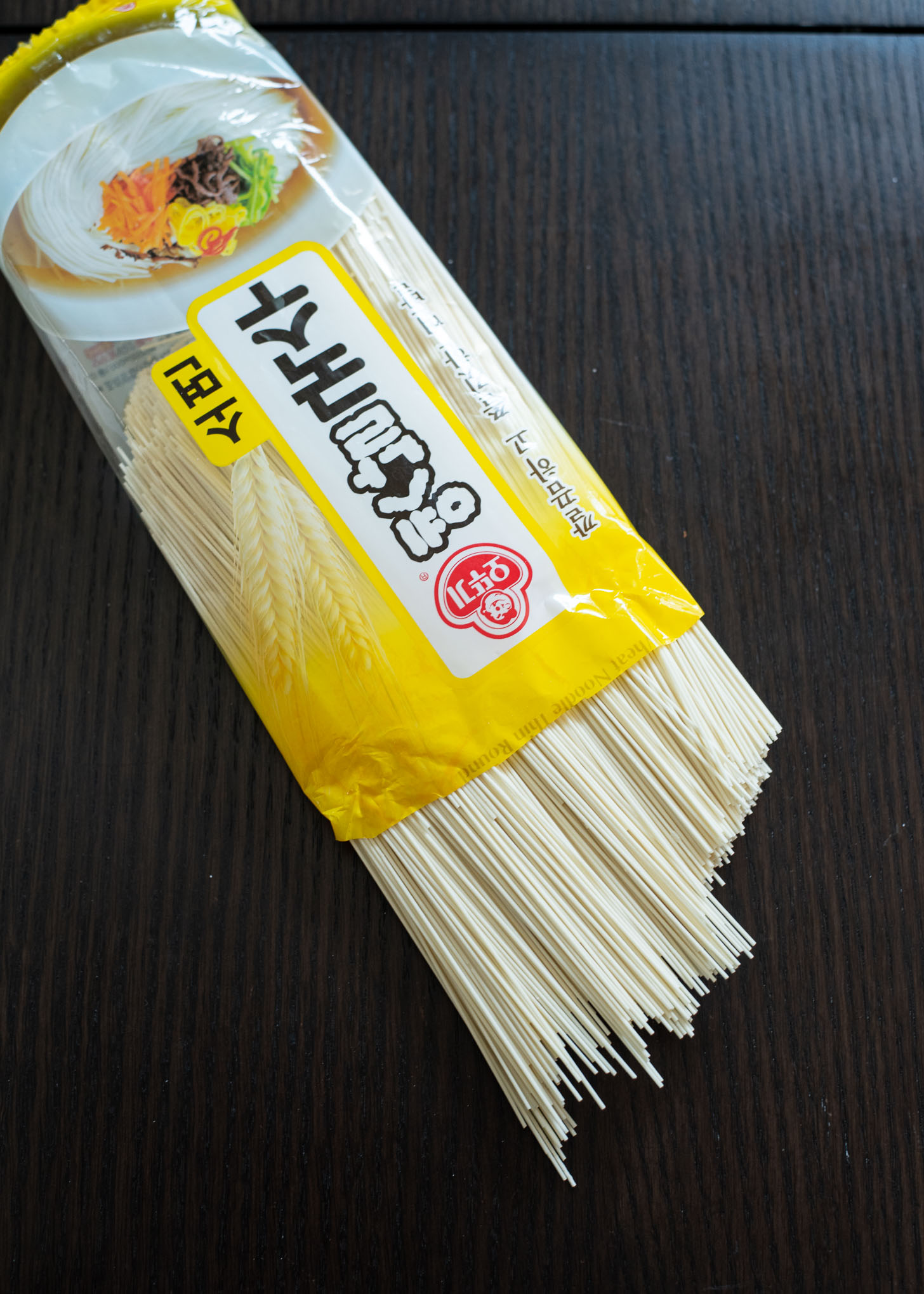
Noodles (Somyeon)
For the best texture in bibim guksu, I recommend using somyeon (소면)—thin Korean wheat noodles. Some packages may also say makguksu (막국수), which are similar in shape but often slightly chewier.
After boiling, rinsing them under very cold water isn’t just to cool them—it also tightens the gluten and gives you that pleasantly chewy bite Korean cold noodles are known for. I always swirl them in ice water for a few seconds before draining—this trick really improves the texture.
Spicy Gochujang Sauce
The flavor of bibim guksu hinges on a well-balanced sauce. I use a base of gochujang (Korean chili paste), but I like to round it out with a splash of rice vinegar for tang, a hint of sugar, and a few drops of sesame oil for nuttiness.
A touch of maesil-cheong (Korean plum syrup) adds depth and a subtle fruity sweetness—it’s optional, but I find it ties everything together beautifully, especially when your kimchi is quite sharp.
Kimchi and Toppings
Chopped aged kimchi adds an instant punch of umami and acidity, which contrasts nicely with the cool noodles. I usually reach for crisp lettuce, thin cucumber strips, and perilla leaves (kkaennip) for a herbal, slightly minty finish.
If you’re making this ahead of time, keep your toppings chilled separately until serving so they stay vibrant and crisp. For protein, a soft-boiled egg adds richness without weighing the dish down.
How to make Bibim Guksu (Korean Cold Noodles)
These step-by-step photos are here to guide you visually through the recipe. For exact measurements and full instructions, scroll down to the printable recipe card below.
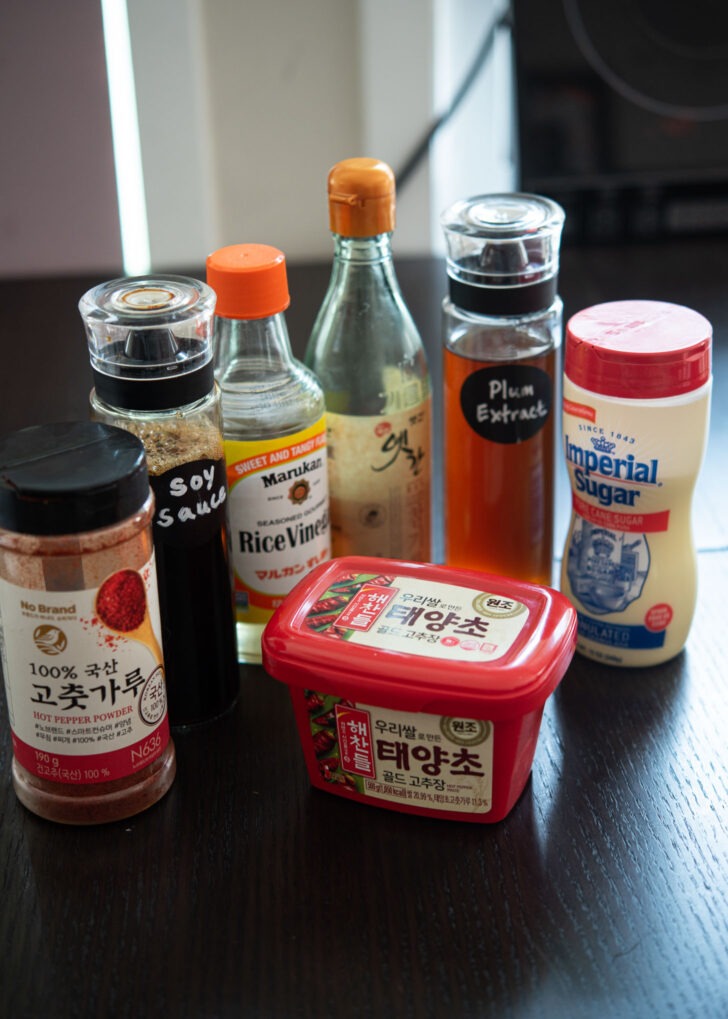
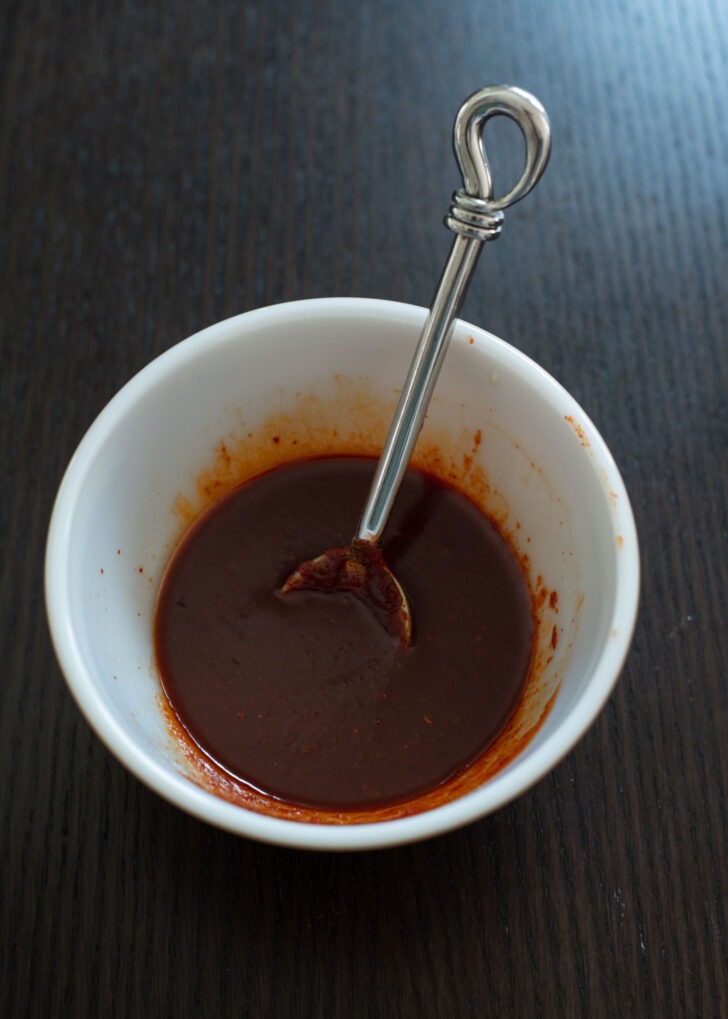
1. Make the sauce: Whisk together the gochujang-based sauce. I like to crush toasted sesame seeds for an extra nutty finish—don’t skip it if you have a mortar.
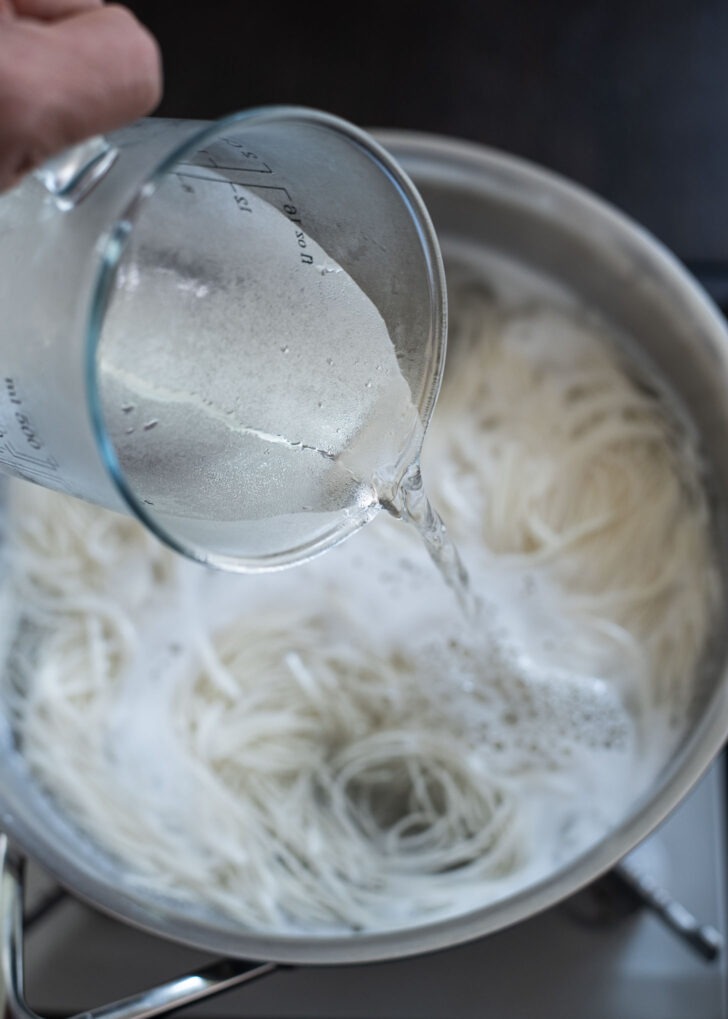
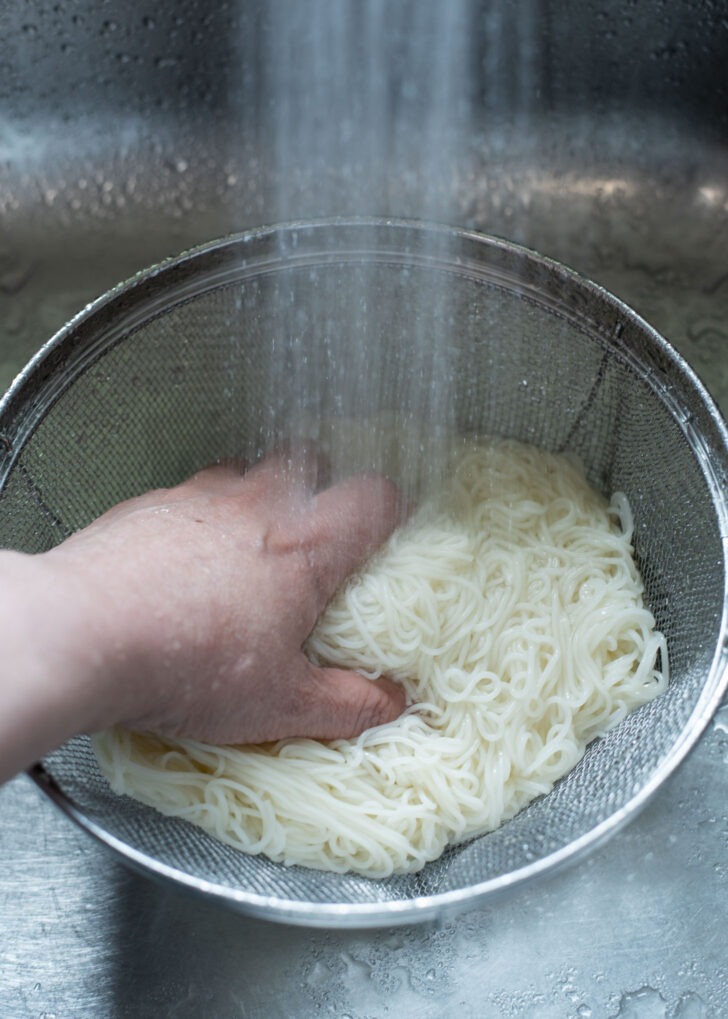
2. Cook the noodles: Boil the somyeon noodles, then rinse them under cold water until they’re cool and chewy. Toss them a bit to help them chill evenly.
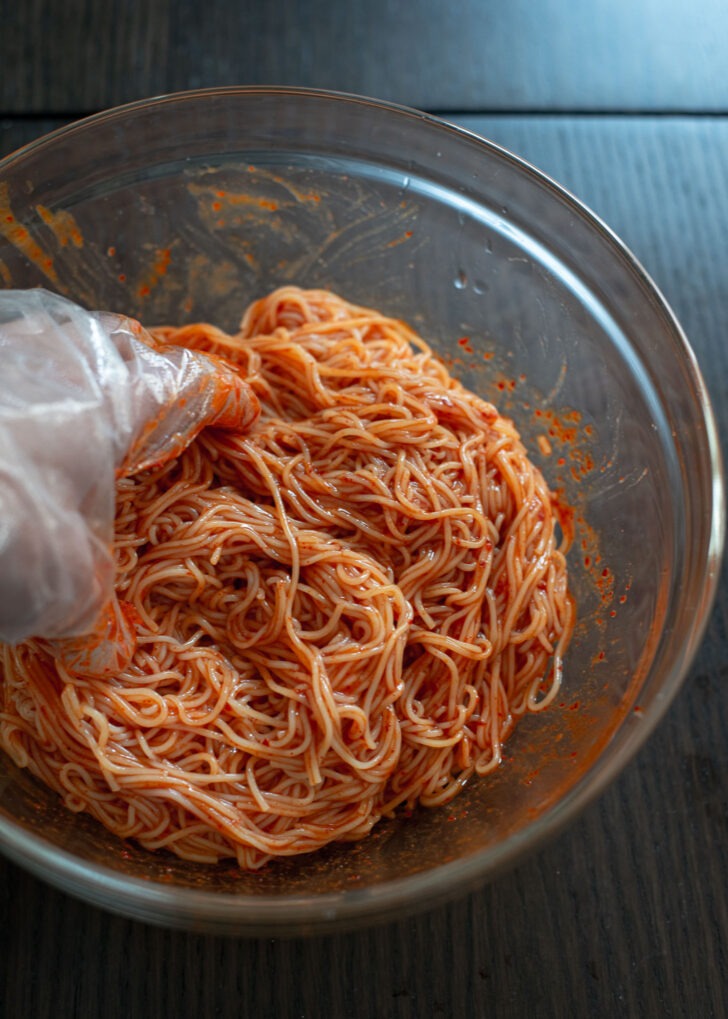
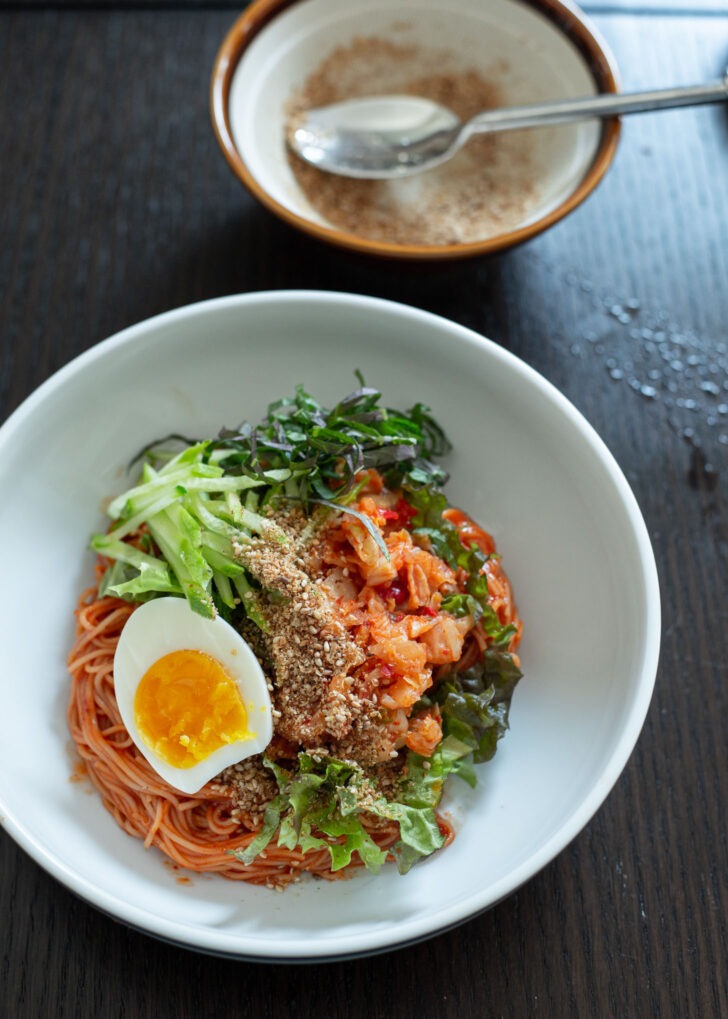
3. Assemble and top: Mix the noodles with your sauce, divide into bowls, and pile on the toppings—kimchi, fresh veggies, maybe a jammy egg. That’s it! Once your bowl is topped and ready, give everything a gentle toss to coat the noodles evenly.
Just a note: bibim guksu is best eaten fresh. The noodles can get soft and soggy if they sit too long, so I recommend making only what you’ll eat in one go. It’s a dish meant to be slurped and shared right away.
More Korean Noodles to Try
- Easy Kongguksu (Cold Soy Milk Noodle Soup)
- Janchi Guksu (Korean Noodle Soup)
- Korean-Style Ground Beef Noodles
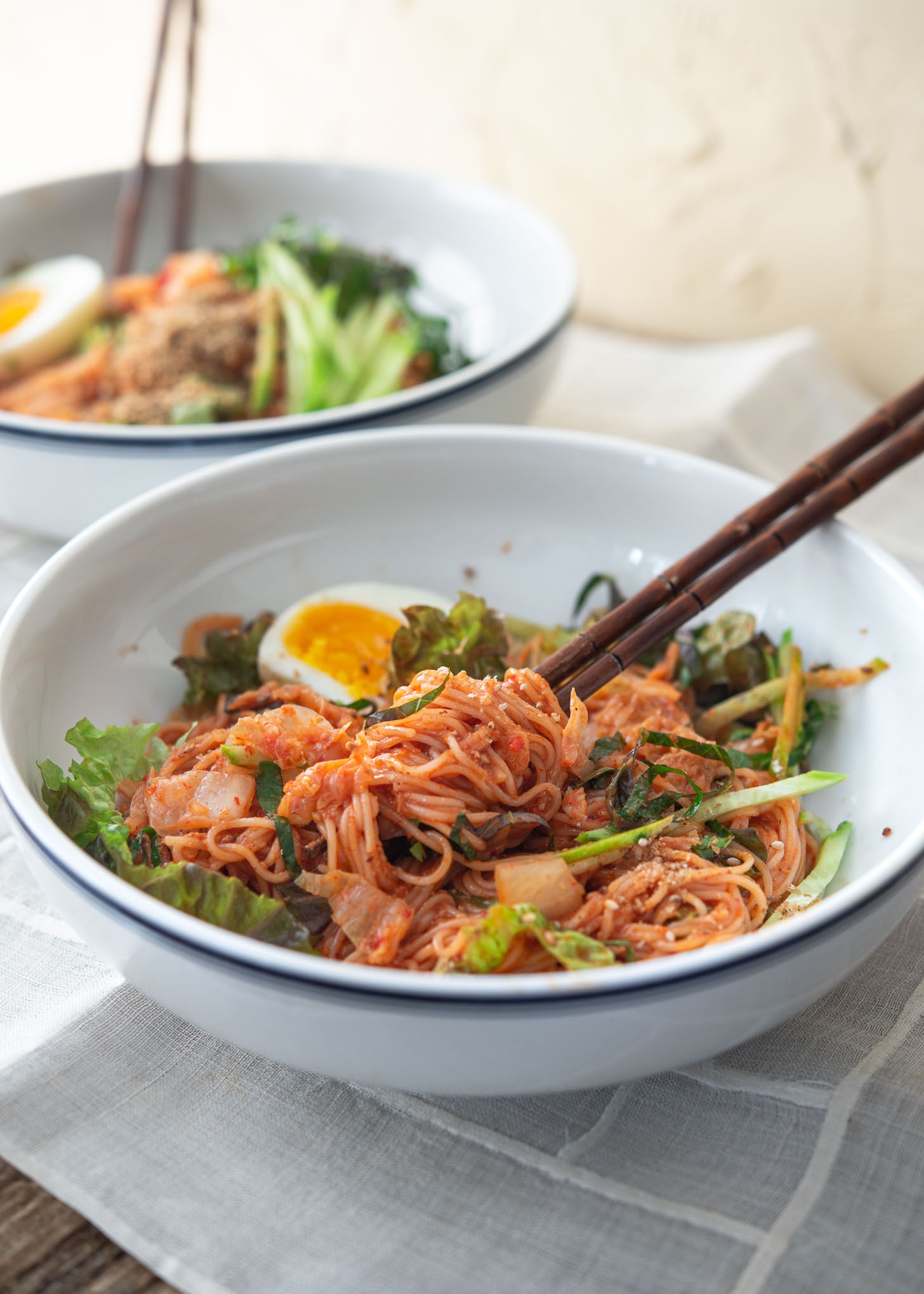
Love this recipe? Rate it and share your experience in the comments below! On Instagram? Tag me to showcase your creation. For more delicious recipes, subscribe to our newsletter!
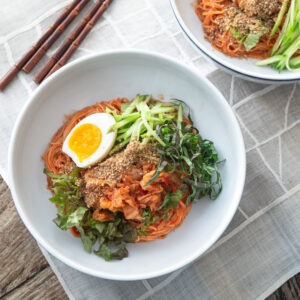
Bibim Guksu (Korean Cold Noodles with Kimchi)
Recipe Video
Ingredients
- 8 oz thin wheat noodles (somyeon)
- 1/2 cup chopped kimchi
- 2 lettuce leaves, shredded
- 1/2 English cucumber, sliced into thin strips
- 2 perilla leaves (kkaennip), sliced, optional
- 1 hard or soft boiled egg, sliced in half (Omit it for vegan diet)
- 1 tbsp toasted sesame seeds, crushed
Bibim sauce
- 2 tbsp Korean chili paste (gochujang)
- 1 tbsp Korean chili flakes (gochugaru)
- 1/2 tbsp soy sauce
- 1 tbsp rice vinegar, or white vinegar
- 1 tbsp sugar
- 1 tbsp sesame oil
- 1 tbsp Korean plum extract (maeshil-cheong), optional
Instructions
- To make the bibim sauce, combine all the sauce ingredients in a bowl and mix well. Set aside. Crush the toasted sesame seeds in a mortar until coarsely ground. Set aside.
- Bring a pot of water to a boil. Add the noodles and cook according to the package directions. To make the noodles chewier, add some cold water when the water comes to a full boil. Repeat this process 2-3 more times whenever the water returns to a boil.
- Drain the noodles in a colander and rinse under cold running water while tossing the noodles around. This helps to cool down the noodles and makes them chewier. Drain the noodles thoroughly.
- Put the cold noodles in a mixing bowl and add the bibim sauce. Toss the noodles with your hands or kitchen tongs until they are evenly coated.
- Divide the noodles into individual serving bowls. Top with your desired toppings, such as chopped kimchi, sliced lettuce, cucumber, shredded cabbage, perilla leaves, and a hard boiled egg. Sprinkle the crushed toasted sesame seeds on top and serve immediately.
Notes
- If your kimchi is especially sour, a spoonful of Korean plum extract (maesil-cheong) can balance it out beautifully.
- Serving for a crowd? Keep the noodles and toppings separate until ready to eat—this helps preserve texture.
- Lightly crush your toasted sesame seeds in a mortar for better aroma and flavor than whole seeds.

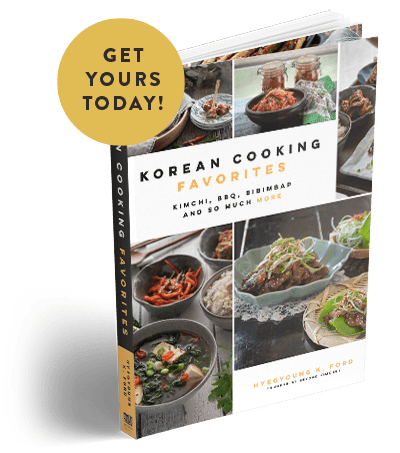
I made this for a quick and easy dinner today – absolutely love this recipe!! It has the perfect amount of heat and is just delicious. I will definitely be making this again 😀
Thanks so much!!
Glad that you loved this guksu. Thank you for the comment!
This recipe is delicious and perfect for hot and humid summer days. Because you only need to boil water (I use an electric kettle), it doesn’t heat up your house when cooking. It’s spicy and flavorful, but also refreshing and savory. I have doubled and quadrupled the recipe with no issue – saving in the fridge seems to make the sauce sink into the noodles even more.
Fabulous noodles, delicious spicy sauce.
My favourite noodles to enjoy when it starts to get warm out! Looks incredibly flavorful!